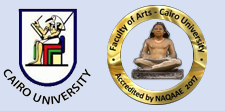عنوان المقال عربي
حالات إشكالية للإشارة الخارجية / الداخلية في ترجمتين حديثتي الصياغة للنص القرآني مع إشارة خاصة إلى الضمائر الوهمية / غير الشخصية
Document Type
Book Review
Keywords English
Keywords: exophoric, endophoric, dummy, reference, Qur’anic translations
Abstract English
This paper is concerned with the investigation into and the translation of certain problematic cases of exophoric/endophoric reference– with particular reference to 'dummy pronouns'– in two modern-phrased translations of the Qur’anic text, namely The Gracious Qur’an: A Modern-phrased Interpretation in English by Ahmad Zaki Hammad, published in 2006 (edition used is that of 2008) and The Qur’an by Saheeh International, published in 1997 (a revised edition of 2004). A translation-oriented text analysis approach is adopted. Certain problematic cases of reference are observed within the range of the present paper to cause real translational dilemmas for translators: sometimes the referent is not only ‘questionable’ pushing the translator to make painful decisions that can result in mistranslations and/or mistakes, but it can be both anaphoric and cataphoric within its micro context as well; even a multi-referent/dummy pronoun! In such a case, the translator is supposed to make a decision that solves the problem and does not affect the communicativeness of the context at the same time. Still, reference ambiguity, in such cases, does have a subtle function and/or purpose that cannot be conveyed in the translation process due to the morpho-syntactic yet pragma-semantic differences between English and Arabic. In this case, the problem is not with the translators, but it, as it were, is with the target language norms and/or traditions.The ultimate objective of this paper, inasmuch as the researcher endeavours to answer its respective research questions, is to give insight into such morpho-syntactic yet pragma-semantic translational problems of reference, on the one hand, and to reach a conclusion of avail to practising translators, on the other hand, eschewing respective translation loss in the examples selected as well as in similar ones.
الملخص العربي
تهتم هذه الورقة بالتحقيق في وترجمة بعض الحالات الإشكالية للإشارة الخارجية / الداخلية - مع إشارة خاصة إلى "الضمائر الوهمية" - في ترجمتين حديثتين للنص القرآني ، وهما القرآن الكريم. : تفسير حديث باللغة الإنجليزية لأحمد زكي حماد ، نشر في عام 2006 (النسخة المستخدمة هي نسخة 2008) والقرآن من قبل صحيح الدولية ، نشر في عام 1997 (نسخة منقحة عام 2004). تم اعتماد نهج تحليل النص الموجه نحو الترجمة. لوحظت حالات مرجعية معينة إشكالية ضمن نطاق هذه الورقة لتسبب معضلات ترجمة حقيقية للمترجمين: في بعض الأحيان لا يكون المرجع `` مشكوكًا فيه '' فقط يدفع المترجم إلى اتخاذ قرارات مؤلمة يمكن أن تؤدي إلى أخطاء في الترجمة و / أو أخطاء ، يمكن أن تكون مجوفة ومخاطرة في سياقها الجزئي أيضًا ؛ حتى ضمير متعدد المراجع / وهمي! في مثل هذه الحالة ، من المفترض أن يتخذ المترجم قرارًا يحل المشكلة ولا يؤثر على تواصل السياق في نفس الوقت. ومع ذلك ، فإن الغموض المرجعي ، في مثل هذه الحالات ، له وظيفة و / أو غرض خفي لا يمكن نقله في عملية الترجمة بسبب الاختلافات الصرفية-النحوية والعملية-الدلالية بين الإنجليزية والعربية. في هذه الحالة ، لا تكمن المشكلة في المترجمين ، لكنها ، كما كانت ، تكمن في معايير و / أو تقاليد اللغة الهدف. الهدف النهائي لهذه الورقة ، بقدر ما يسعى الباحث للإجابة على أسئلة البحث الخاصة به ، هو إلقاء نظرة ثاقبة على مشاكل الترجمة الصرفية والنحوية العملية ، من ناحية ، والتوصل إلى نتيجة مفيدة من ناحية أخرى ، يتجنب المترجمون الممارسون خسارة الترجمة ذات الصلة في الأمثلة المختارة وكذلك في الأمثلة المماثلة.
Recommended Citation
Alghazi, Muhammad Fawzi
(2019)
"Problematic Cases of Exophoric/Endophoric Reference in Two Modern-phrased Translations of the Qur’anic Text with Particular Reference to Dummy/Impersonal Pronouns,"
Journal of the Faculty of Arts (JFA): Vol. 79:
Iss.
4, Article 6.
DOI: 10.21608/jarts.2019.81811
Available at:
https://jfa.cu.edu.eg/journal/vol79/iss4/6
Digital Object Identifier (DOI)
10.21608/jarts.2019.81811
Accept Date
2018-04-12
Publication Date
10-1-2019

